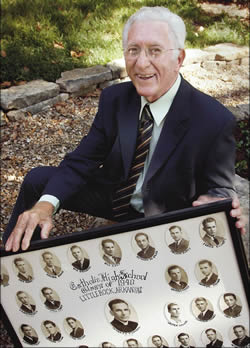College of Engineering
4183 Bell Engineering Center
Fayetteville, AR 72701
Phone: 479-575-7780
John Walter Keller Jr.
BSEE ’46; MS Math ‘48; MS Physics ‘50
John Walter Keller Jr.’s professional life throughout the second half of the 20th century in many ways tracks the progress of American engineering technology during that time. When he retired in 1985 from his longstanding position as Adjunct Professor at the University of Miami, he concluded a career spanning almost 50 years of engineering innovation.
Graduating from the University of Arkansas in 1948, Walter took a job as Electronic Engineer at the U.S. Naval Research Laboratory in Washington, D.C. He was quickly singled out for assignment in the South Pacific, where he participated in research related to Operation Sandstone and Operation Greenhouse, key components of the series of American nuclear test series being conducted at that time.
Following several years with the Naval Research Laboratory, Walter joined what was then known as the Harry Diamond Laboratories at the U.S. National Bureau of Standards as an Electronic Physicist. Today known as the Army Research Laboratory, this facility housed research on proximity fuses for guided missiles, including nuclear-capable rockets. Entrusted with some of the most technically sensitive research of his time, Walter Keller spent five years at U.S. NBS before leaving government service to work in industry.
In 1959 he took a position with Cordis Corporation, where his career took a decidedly different turn. There, as Staff Physicist, he became the originator and systems/electronic designer of a pacemaking program that would eventually yield the world’s first implantable, remotely programmable digital pacemaker. While the concept for such technology was widely known and discussed, it was Walter’s work on Corids’ “Atricor” device that enabled the first prosthetic device to automatically control a physiologic parameter. This innovation dramatically altered life for the hundreds of thousands of patients who would ultimately benefit from Walter’s implantable device and its technological descendants.
From 1969 to 1985, Walter built on his early breakthroughs in medical engineering to create a successful career in biomedical engineering that included organizing a Biomedical Engineering Department at the Miami Heart Institute, serving as Vice President for ESB-Medcor (a pacer systems company), and as an independent consultant to numerous biomedical firms in the cardiac space.
Walter holds a Bachelor’s degree in Electrical Engineering and two Master’s degrees –in Physics and Math - from the University of Arkansas. From 1958 to 1985 he served as an Adjunct Professor at the University of Miami in Florida. He has been recognized as a Distinguished Alumnus by the University of Arkansas Alumni Association (1991), the University of Arkansas at Little Rock (formerly Little Rock Junior College) (2001) and by Little Rock Catholic High School. He lives with his wife of 56 years, Jinny, in Tequesta, Florida. Together, they have 12 children, 27 grandchildren and 4 great-grand children.